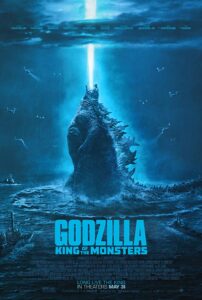Godzilla’s monstrous presence looms large, making little room for a coherent and engaging story.


If Michael Bay had directed a “Godzilla” movie, it would be “Godzilla: King of the Monsters.” And while another Michael, Michael Doughtery, the one that directed 2015’s “Krampus,” is at the helm of “King of the Monsters,” he can’t shake the Bay style, the same style that gave us the diminishing returns and bonkers nonsense of the “Transformers” franchise. And toeing the Bay line, in Doughtery’s monster movie, skyscrapers topple, nameless and faceless innocents are crushed to paste, and entire communities are extinguished in bursts of atomic dragon fire. Oh, and there are jokes.
To be fair, “King of the Monsters” is meant to be ridiculous. The inventive kaiju films were launched back in 1954 and then “Americanized” in 1956, adding Canadian actor Raymond Burr to essentially narrate the story for US audiences. That 1956 movie was similarly titled “Godzilla, King of the Monsters!.” Although I’ve not seen the original Japanese 1954 cut, I’ve read that it took a much more anti-nuclear position. Of course, given the events in Japan that resulted in their exit from WWII, such a position was understandable. Preserved in this 2019 update is the idea that Godzilla, and other monsters, were awakened by nuclear testing.

And in this new, big-budgeted Godzilla film, the third in what’s being referred to as a “MonsterVerse,” universal environmental themes are expanded. The story picks up in the years after the events of 2014’s “Godzilla.” In that movie, Godzilla battled creatures that fed on nuclear energy. The result was destruction of San Francisco.
The drama in 2014’s “Godzilla” focused on military officer Ford Brody (Aaron Taylor-Johnson), whose father, Joe (Bryan Cranston), believed that the nuclear plant disaster that took his wife was caused by a kaiju (monster). That film’s opening, in which a nuclear plant is attacked, is an impressive sequence, filled with effective sentimentality, largely achieved by Cranston’s devoted performance and a brief and emotional appearance by Juliette Binoche.
Unlike the lump in your throat that may have swelled when Cranston’s Joe is forced to make an impossible and heart-wrenching decision, there’s nothing with any serious dramatic weight or impact in “King of the Monsters.” The latest story focuses on the Russell family, Mark (Kyle Chandler), Emma (Vera Farmiga) and their daughter Madison (“Stranger Things” star Millie Bobby Brown). Tragically, we learn that the family’s eldest child was killed in the monster rampage of 2014. Due to the grief and regret, Mark and Emma have become estranged. Madison lives with mom, who works for the extra-governmental crypto-zoological agency Monarch.

Emma is a scientist specializing in the study of bioacoustics. Like Mark, she uses sound to understand the behavior of animals. But Emma’s work offers a chance to control the kaiju, and she’s built a device to isolate their bioacoustic signatures. That device, called the ORCA, resembles a portable DJ mixing system complete with XLR outputs. And, as there always are in the movies, there’s only one of them.
When an evil eco-terrorist group, led by mercenary Jonah Alan (the always villainous Charles Dance), gets control of the OCRA, the Monarch team has to stop them. Meanwhile, some 17 kaijus are released including the three-headed King Ghidorah. And as the various monsters emerge from centuries of peaceful slumber, they come under the Ghidorah spell. It’s hell on earth in no time.
As it should be, the best thing about “King of the Monsters” is the monsters. The human story is weak and distracting. As the Russells and the eclectic Monarch crew race to recapture the ORCA, any logic is thrown to the winds. Monarch is like a low-rent version of Marvel’s S.H.I.E.L.D., that has, it seems, unlimited resources to draw upon. Monarch employees (played by returning Ken Watanabe and Sally Hawkins, along with newcomers Ziyi Zhang, Thomas Middleditch and Bradley Whitford) zip around the world in a massive flying wing. And, when needed, they explore the ocean depths in a military submarine. This happens, I think, without as much as a wardrobe change. Characters pop up, in and out, all over the globe, traveling thousands of miles in what seems like minutes. It’s almost too much to take.
Don’t get me wrong; I know this is a monster movie, and we aren’t supposed to think too hard about anything. But this film barely gets by on spectacle, making it the least intelligent and least entertaining entry to date. It’s sporadically fun, sure, to see the beasts clash, but we’ve seen this kind of thing so many times before, that by the third confrontation, you get a little exhausted. After the umpteenth building crumbles, you might even get a little bored. And since the human characters aren’t engaging, you might even start looking at your watch.

“Godzilla: King of the Monsters” is good enough to whet fan appetite for the inevitable blending of this story with that of King Kong. It’s a franchise episode that’s surprisingly not as good as 2017’s “Kong: Skull Island,” which featured better looking creatures and a campy Vietnam war tinged mystique. When the next MonsterVerse film hits theaters, let’s hope that as much effort is put into crafting the human story as they do in creating the monster one. Maybe the problem is that Godzilla is such a big presence that there’s no room for anyone or anything else. Maybe it will take Kong to make us care again.
